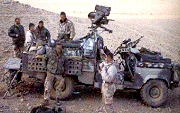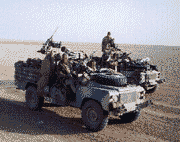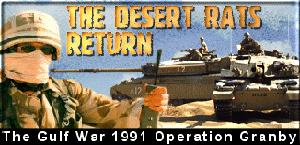The SAS Operations
During the buildup to Desert Storm, General Norman Schwarzkopf had little regard for Special Forces, being a veteran of Vietnam, and Grenada, and as a result it seemed unlikely, that US Special Forces and the British SAS would be used. Fortunately, the commander of the British Forces, Lieutenant-General Peter de la Billire, was a veteran of the SAS, and a former commander of 22 SAS, who managed to convince Schwarzkopf that the very special skills of the SAS would be invaluable.
Shortly after Christmas 1990, the SAS, having been on standby for action for months, left for the Gulf, commencing the largest deployment of the regiment since 1945, with men from A, B and D Squadrons. However, no immediate role was seen for them, as US Special Forces had already taken the border reconnaissance roles. It was proposed instead, to use the SAS and Delta Force to rescue the hundreds of foreign nationals being held as hostages in Saddam Hussien's "human shield" policy. But, this was a logistical impossibility, as the hostages were held in various locations all over the country, and too many lives would be lost, both soldiers, and hostages.
By mid-January 1991, the British commander decided the SAS could be effective in creating diversion ahead of the main attack, destroying Iraqi communications facilities, and tracking down mobile Scud missile launchers, which, had so far evaded both air and satellite reconnaissance. The SAS were to undertake these operations on the night of 22/23 January, 6 days before the start of hostilities. But, events took people by surprise, and on 17th January, the air war began.
Saddam Hussein resorted to his Scuds to strike back, his command and control infrastructure effectively crippled from the start. The SAS were immediately ordered to find and destroy the mobile Scud launchers, having been inserted by helicopters, and set about their task with road watch patrols, and desert fighting columns. As a result, Israel backed down from it's threat to retaliate.
The SAS were forced to operate in dry, arid desert, which offered little cover, and the desert attire they had been supplied with offered little protection against the freezing nighttime temperatures, snow, sleet, and rain. The men developed frostbite and hypothermia.
The SAS also engaged targets of opportunity, marking targets for air strikes with laser designators, for pinpoint bombing accuracy, and, by the end of the war, had been involved in the destruction of many communications facilities, and, it is estimated, about a third of the Scud launchers.

Resupply of the SAS units in the desert was carried out by a temporary formation, E Squadron, which was an SAS run, re-supply convoy, comprising ten trucks and a heavily armed Land Rover escort, moving to a Rendezvous (RV) some 139km inside Iraq, where they would meet up with the fighting columns. The RV was a hive of activity, reached by 1500 hours on 12th February, having left on the morning of 10th February. Here, the vehicles were serviced or repaired, and prisoners held, and a meeting was called by the RSM, of the Warrant Officers and Sergeants, which was held on 16th February, and consisted of over 390 NCOs. The convoy returned to Saudi Arabia on the 17th February, and E squadron ceased to exist.
Despite dangerous terrain, dreadful weather, intelligence mistakes, and radio problems, the regiment lost only four soldiers. In recognition of it's service, the regiment received 55 medals for gallantry and meritorious service. General Schwarzkopf thanked the SAS with his personal commendation, for their work.
Bravo Two Zero
On the evening of 22nd January 1991, eight members of a patrol with the callsign, "Bravo Two Zero", were infiltrated by Chinook helicopter, into Iraq. Their task, was to observe the main supply route and to sever underground communications cables, which ran between Baghdad and Jordan. In addition, they were to seek and destroy any Scud missiles in the area. Each member of the patrol was overloaded with stores and equipment for the stay, and once landed, the patrol moved some 20km, to where they found a small cave, in which, they chose to hide.
The Patrol was led by Sergeant Andy McNab (an Alias) who soon realized, their radio was not working, this meant returning to the landing zone, and meeting a helicopter to obtain a new radio. The patrol soon found themselves in a difficult position, and decided to move, during which time, they made contact with the enemy. A vicious firefight ensued, and the patrol was forced to withdraw, heading for the Syrian border some 120km west. The journey was hard and dangerous, and the area was experiencing the worst weather in it's history.
Through hypothermia and injury, the patrol became separated, and as a result, three died, 4 were captured, and one, managed to escape. Those that were captured by the Iraqis, faced weeks of beatings, and horrendous torture. In the end, they were released with the other POW's and returned to the regiment.
The details of the trials and tribulations of this patrol, are available in the following books: Bravo Two Zero, by Andy McNab, and, The One That Got Away, told by the member of the patrol that reached the Syrian border, Chris Ryan.
The Road Watch Patrol
Consisted of eight men, positioned far behind enemy lines by helicopter, who set up static observation posts to survey the main supply routes for the movement of Scud launchers. They would then call by radio for air strikes to destroy the vehicles.
Desert Fighting Column

These were formed by the SAs during the Gulf War, and designed to infiltrate Iraqi territory to carry out search and destroy missions. The firepower carried, was enough to ensure they could destroy just about anything they could find. This strategy was employed, to force the Iraqis to deploy large forces in order to locate them. Each squadron was divided into two fighting columns, training for which, had been carried out in the united Arab Emirates. In each column a Unimog, a Mercedes-made, short-wheel base open truck, was used as the mother vehicle. This would carry the bulk of the supplies, fuel, ammunition, NBC equipment, and spares. The fighting vehicles in each column consisted of between eight and twelve, type 110 Land Rovers, each of which, was armed with a Browning .50 cal. heavy machine gun. Additional weapons included GPMGs, American Mark 19 40mm Grenade launchers, and Milan anti-tank missiles. The Columns were effective at night, preferring to lay up in the day to avoid detection. All the SAS columns stayed inside Iraq for the full duration of the war.



